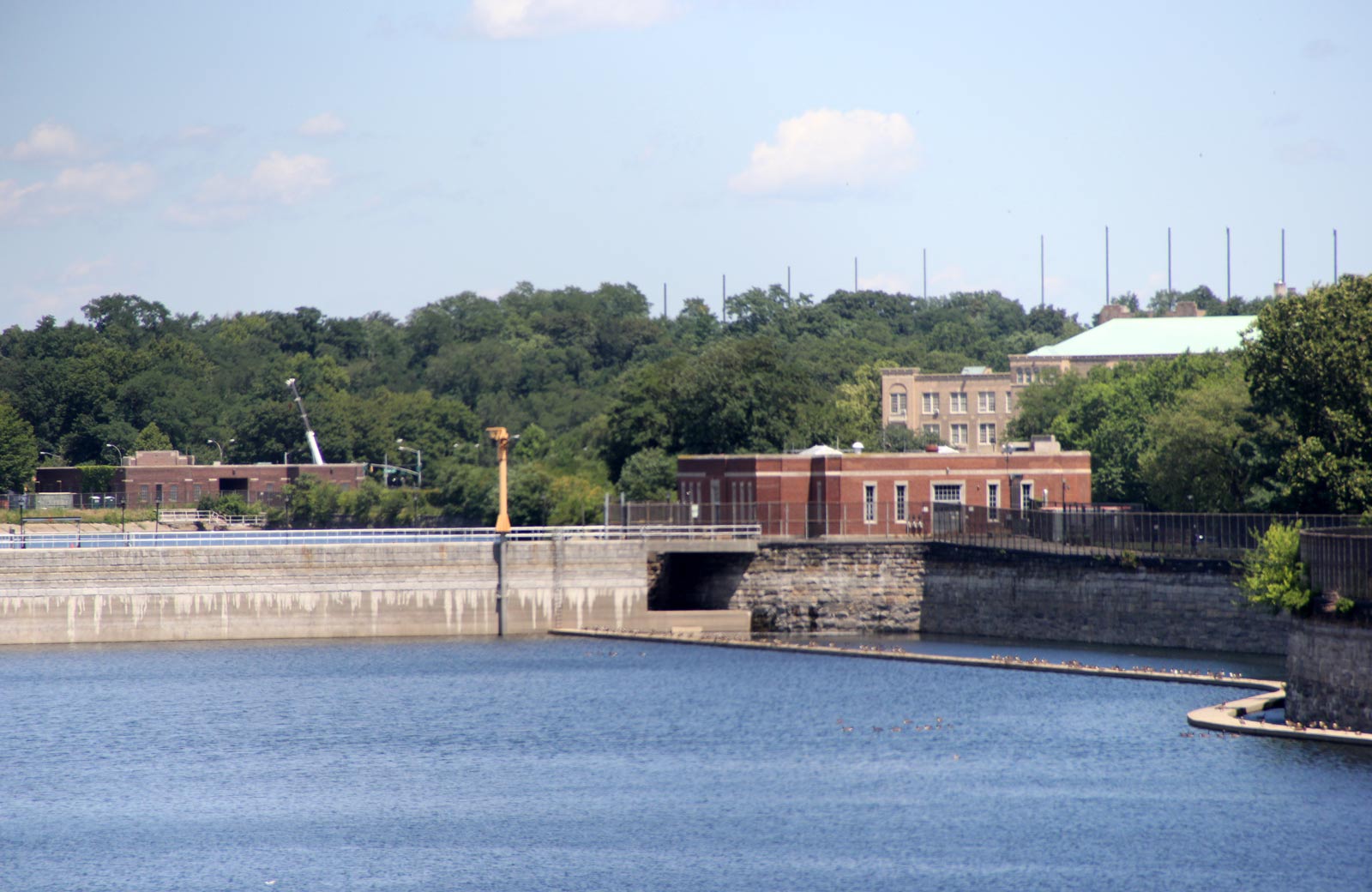
Jerome Park Reservoir has seven
gatehouses: three offsite and four onsite such as the two shown here,
the darker brick Gatehouse No.7 at left
and the lighter brick Gatehouse No.5 at
right. Gatehouses control the flow of water into and out of the reservoir
via gates, sluices, and pumps and may also perform other functions such as
filtering and chlorination. The original 1906 reservoir had gates and
sluices but the buildings to contain them were not built as planned for lack
of funds, which did not appear until the New Deal. The above-grade
superstructures (the brick buildings you see in this and the following
pictures) were designed by the NY Department of Water Supply Gas and
Electric (DWSG&E) and the Works Progress Administration (WPA) and built
by the WPA in 1938-1939[1]; they contain such things as sluice gate controls,
chlorinating equipment controls, switch rooms, equipment and boat storage,
offices, and locker rooms.
References:
- Final Supplemental Environmental Impact Statement for the Croton Water Treatment Plant, nyc.gov archive. This is Section 8.2 of The Croton Water Filtration Plant Project: Final Supplemental Environmental Impact Statement, July 16, 2004: “In 1938, designs were prepared for Gate Houses Nos. 2, 5, and 7. Plans were prepared by the Design Unit, Project Planning Section, Division of Operations, and Works Progress Administration (WPA). No architect's name is associated with these designs since they were prepared by the federal staff of the WPA for the New York City DWSG&E. There is no evidence that the construction of these gate houses entailed any changes to the mechanical systems of the Reservoir. While apparently there had been interest in building gate house superstructures from the time that Jerome Park Reservoir opened in 1906, it was not until 1938 that funds were available for this work. The smaller gate houses surrounding the Reservoir appear to be similar to those designed by the WPA in 1938, but no evidence has been located as to how these were funded or who built them .... The WPA funded a significant number of New York City projects relating to the water system, including surveys, water main installations, and the alteration, repair, and construction of buildings. The designs for Gate Houses Nos. 2, 5, and 7 are nearly identical to the completed buildings. The buildings generally retain their integrity.”
- Appendix D.3 Historical and Archaeological Resources, Harlem River Site, Bronx, 1998, at s-media/nyc.gov.
- Quilty, Patrick, "WPA Projects in New York City", Municipal Engineers Journal, Vol.25:106-107 (1939)
- Soll, David, Empire of Water, An environmental and Political History of the New York City Water Supply, Cornell University Press (2013).
- An Enduring Legacy: The New Deal's 'Water Waste Force', DEP newsletter Weekly Pipeline, November 22, 2011: “The Department of Water Supply, Gas and Electricity (DWSGE), a DEP predecessor agency, immediately applied to take on WPA employees who were greatly needed for a variety of projects. In the first year of the program, the average number of WPA workers employed by the department each month was about 2,100. This force consisted of 1,490 laborers, 593 skilled mechanics, and 52 draftsmen and clerks. The types of projects that the WPA employees worked on varied but the most common ones included making repairs to department buildings, pumping stations and gatehouses; erecting and painting fences; and building garages and repair yards. Another important project that WPA workers were involved with was a large scale real estate survey of NYC that was instrumental in the departments expansion of the water supply system.” (DEP is today's New York City Department of Environmental Protection.)